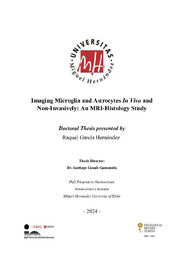Por favor, use este identificador para citar o enlazar este ítem:
https://hdl.handle.net/11000/34132Registro completo de metadatos
| Campo DC | Valor | Lengua/Idioma |
|---|---|---|
| dc.contributor.advisor | Canals Gamoneda, Santiago | - |
| dc.contributor.author | García Hernández, Raquel | - |
| dc.contributor.other | Instituto de Neurociencias | es_ES |
| dc.date.accessioned | 2024-12-12T10:16:38Z | - |
| dc.date.available | 2024-12-12T10:16:38Z | - |
| dc.date.created | 2024-07-24 | - |
| dc.identifier.ismn | 1792 | - |
| dc.identifier.uri | https://hdl.handle.net/11000/34132 | - |
| dc.description.abstract | Neuroinflammation is a central topic of research in neuroscience due to its implication in the development of numerous neurological and psychiatric disorders. However, to date, there are no imaging techniques capable of characterising brain inflammation in vivo and non-invasively. In this study, we propose a novel approach to visualise microglial and astrocytic reactions in the gray matter using diffusion-weighted magnetic resonance imaging (dw-MRI). To demonstrate it, we employed various animal models in rats and conducted a pilot study in humans to explore its clinical utility. The study is based on 1) the ability of dw-MRI to study structural changes in different cellular compartments, 2) the characteristic morphology of glial cells, and 3) their known morphological change in response to an inflammatory process. The available animal models allowed us to generate time windows to distinguish the microglial response from the astrocytic response (longitudinal study after lipopolysaccharide treatment), as well as to induce inflammatory responses in the absence (lipopolysaccharide) or presence (ibotenic acid) of neurodegeneration or demyelination (lysolecithin). Finally, the specific footprint left by microglial reaction in dw-MRI could be verified in experiments with PLX5622, a compound that produces almost complete microglia depletion in the tissue. The combination of dw-MRI and histological studies in the same animals allowed us to demonstrate a high correlation between cell type-specific histological measurements and specific compartments defined in dw-MRI. Overall, our experiments with animal models demonstrate that 1) it is possible to non-invasively measure the reaction of microglia and astrocytes in an inflammatory process, 2) the reaction of both cell types can be distinguished and quantified separately, even though both occur simultaneously, and 3) this capability of dw-MRI is not affected in cases of neuronal death or axonal demyelination, two alterations that themselves modify water diffusion in the tissue. Finally, we adapted our dw-MRI protocol to a human research scanner and demonstrated its ability to estimate microglial density in several brain regions in six healthy human patients, corroborated by post mortem data from the literature. These results underscore the potential of our approach to obtain non-invasive images of microglia and astrocytes in vivo. We anticipate that this model will significantly contribute to our understanding of glial functions in both health and disease. | es_ES |
| dc.format | application/pdf | es_ES |
| dc.format.extent | 163 | es_ES |
| dc.language.iso | eng | es_ES |
| dc.publisher | Universidad Miguel Hernández | es_ES |
| dc.rights | info:eu-repo/semantics/openAccess | es_ES |
| dc.rights.uri | http://creativecommons.org/licenses/by-nc-nd/4.0/ | * |
| dc.subject | Neurociencias | es_ES |
| dc.subject | Resonancia magnética nuclear | es_ES |
| dc.subject | Histología animal | es_ES |
| dc.subject.other | CDU::6 - Ciencias aplicadas::61 - Medicina::616 - Patología. Medicina clínica. Oncología::616.8 - Neurología. Neuropatología. Sistema nervioso | es_ES |
| dc.title | Imaging Microglia and Astrocytes In Vivo and Non-Invasively: An MRI-Histology Study | es_ES |
| dc.type | info:eu-repo/semantics/doctoralThesis | es_ES |
| dc.contributor.institute | Institutos de la UMH::Instituto de Neurociencias | es_ES |

Ver/Abrir:
TESIS SF GarciaHernandez_Raquel_compressed.pdf
2,85 MB
Adobe PDF
Compartir:
 La licencia se describe como: Atribución-NonComercial-NoDerivada 4.0 Internacional.
La licencia se describe como: Atribución-NonComercial-NoDerivada 4.0 Internacional.
.png)